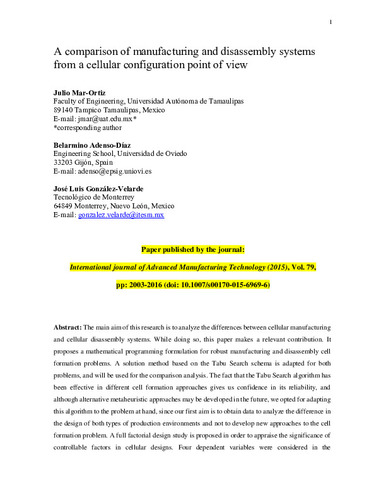A comparison of manufacturing and disassembly systems from a cellular configuration point of view
Autor(es) y otros:
Palabra(s) clave:
Cell formation problem
Cellular manufacturing
Disassembly
Robust optimization
Operational research
Fecha de publicación:
Editorial:
Springer
Versión del editor:
Citación:
Descripción física:
Resumen:
The main aim of this research is to analyze the differences between cellular manufacturing and cellular disassembly systems. While doing so, this paper makes a relevant contribution. It proposes a mathematical programming formulation for robust manufacturing and disassembly cell formation problems. A solution method based on the Tabu Search schema is adapted for both problems, and will be used for the comparison analysis. The fact that the Tabu Search algorithm has been effective in different cell formation approaches gives us confidence in its reliability, and although alternative metaheuristic approaches may be developed in the future, we opted for adapting this algorithm to the problem at hand, since our first aim is to obtain data to analyze the difference in the design of both types of production environments and not to develop new approaches to the cell formation problem. A full factorial design study is proposed in order to appraise the significance of controllable factors in cellular designs. Four dependent variables were considered in the experiments: total cost, size of the cells, number of intercellular moves, and machine utilization. The issue here is to see what happens with the solutions for each production environment (manufacturing and disassembly) when varying factors, in order to analyze the differences and similarities between both.
The main aim of this research is to analyze the differences between cellular manufacturing and cellular disassembly systems. While doing so, this paper makes a relevant contribution. It proposes a mathematical programming formulation for robust manufacturing and disassembly cell formation problems. A solution method based on the Tabu Search schema is adapted for both problems, and will be used for the comparison analysis. The fact that the Tabu Search algorithm has been effective in different cell formation approaches gives us confidence in its reliability, and although alternative metaheuristic approaches may be developed in the future, we opted for adapting this algorithm to the problem at hand, since our first aim is to obtain data to analyze the difference in the design of both types of production environments and not to develop new approaches to the cell formation problem. A full factorial design study is proposed in order to appraise the significance of controllable factors in cellular designs. Four dependent variables were considered in the experiments: total cost, size of the cells, number of intercellular moves, and machine utilization. The issue here is to see what happens with the solutions for each production environment (manufacturing and disassembly) when varying factors, in order to analyze the differences and similarities between both.
Patrocinado por:
The research activity of JLGV has been partially funded by the Tecnológico de Monterrey–Research Group in Industrial Engineering and Numerical Methods 0822B01006 and by the Mexican National Council for Science and Technology (CONACyT) through grant SEP-CONACyT CB-2011-01-166397. JMO acknowledges the support of Universidad Autónoma de Tamaulipas through research fund PFI2014-34. BA-D is granted by the Spanish Ministry of Science(grant DPI2013-41469-P) and the European Regional Development Fund (ERDF).
Colecciones
- Administración de Empresas [514]
- Artículos [37541]
- Investigaciones y Documentos OpenAIRE [8415]
Ficheros en el ítem





